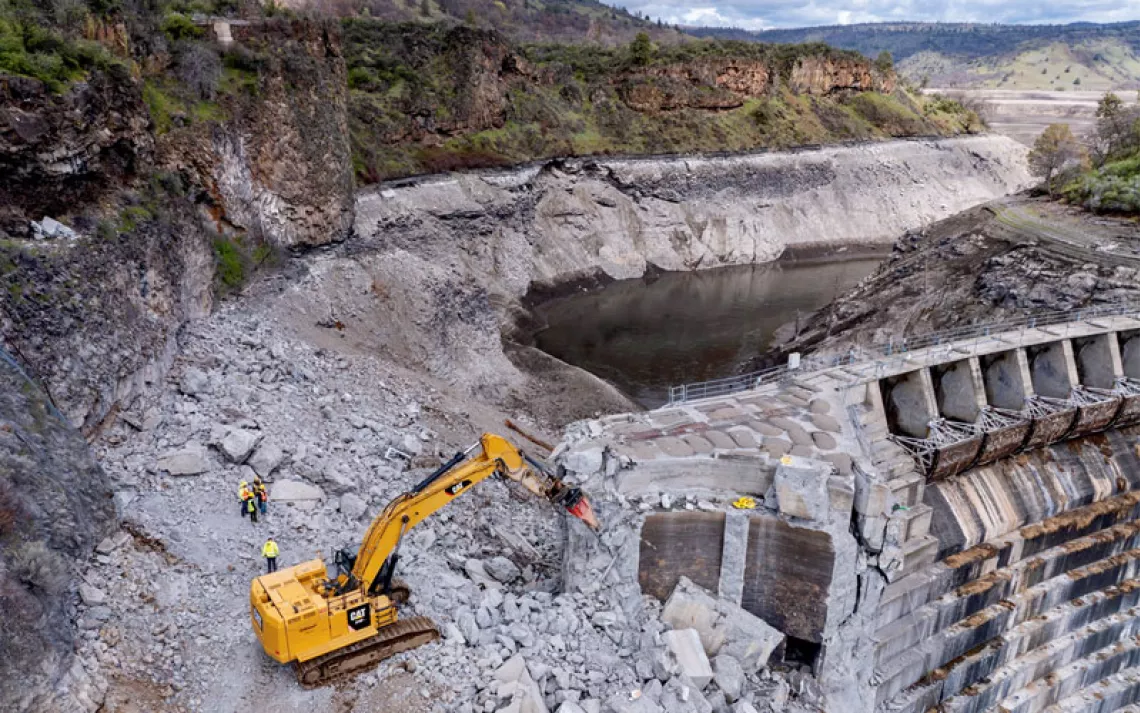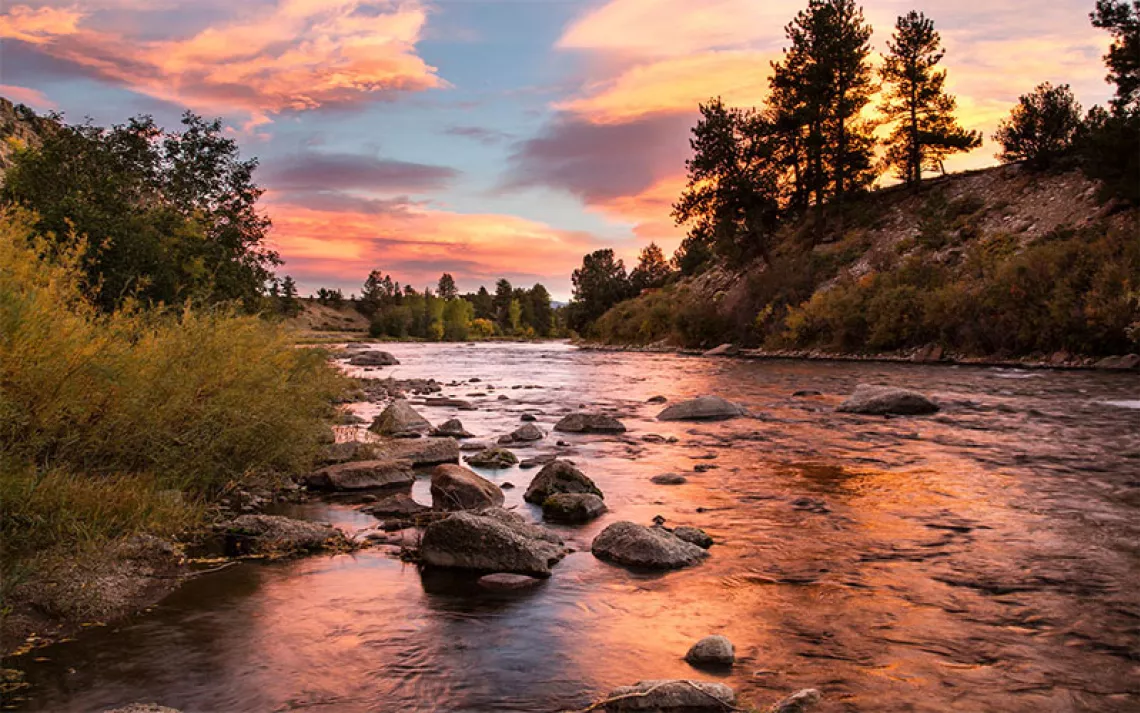Will the Snake River’s Dams Be the Next to Come Down?
A multibillion-dollar rescue package to pull Idaho’s salmon back from extinction

The Lower Granite Dam on the Snake River near Almota, Washington, is one of four salmon-blocking dams on the Snake that may be torn down. | Photo by AP Photo/Nicholas K. Geranios
In the spring of 2019, Representative Mike Simpson, the Republican congressman who represents central and eastern Idaho, gave the keynote address at a conference titled Energy, Salmon, Agriculture, and Community at the Andrus Center for Public Policy at Boise State University. Simpson described what he saw as the two biggest challenges facing the Pacific Northwest today: a salmon population on the edge of extinction and the economic uncertainty facing the Bonneville Power Administration, which operates 31 federal hydroelectric dams in the region. The fates of both salmon and the BPA, Simpson said, were interwoven. His speech included phrases seldom uttered by western Republicans—phrases like “dam removal” and “harvest reductions.” “I am going to stay alive long enough,” Simpson declared to applause, “to see salmon return to healthy populations in Idaho.”
Over the next two years, Simpson and his chief of staff, Lindsay Slater, met one-on-one with environmentalists, biologists, energy producers, tribes, and other stakeholders to ask, "What would happen if the four hydroelectric dams on the lower Snake River were breached?" Slater had a massive map of the Columbia Basin that wrapped around the walls of his office. After each meeting, he would post sticky notes filled with bits of data and key insights from their conversation onto the map. Then, last fall, after more than 300 meetings, Simpson told Slater it was time to take the sticky notes down and do something with them.
On February 6, Simpson unveiled his plan, a sweeping $33.5 billion framework to bring back the Snake River’s salmon that he hopes will be part of the multitrillion-dollar infrastructure and clean-energy package President Joe Biden is set to unveil later this year. The centerpiece of Simpson’s plan is the breaching of the four lower Snake River dams, in Washington State, that stand between migrating Chinook salmon and 5,500 miles of near-pristine spawning habitat in central Idaho—including the Boulder–White Clouds Wilderness, more than 275,000 acres in the Sawtooth National Recreation Area that Simpson helped shepherd into law in 2015. “We looked at every possible situation to try to find a way to keep the dams. There’s no way,” Simpson said. “I can’t be certain that removing these four dams will bring back Idaho’s salmon, but I am certain that if we don’t remove them, the salmon are on a certain path to extinction.”
Simpson estimates that the breaching of the dams—starting with Lower Granite, the farthest inland, then progressing downriver—will cost the US Army Corps of Engineers up to $1.4 billion. The bulk of his proposed Columbia Basin Fund would go toward replacing the electricity the dams generate with renewable energy, establishing a series of regional partnerships tasked with restoring salmon habitat, and investing in farmers who rely on the dams for irrigation.
“The genius behind Simpson’s approach is that it’s not only bold but really comprehensive,” said Wendy McDermott, who directs river conservation work in the Puget Sound and Columbia Basin for American Rivers. “He has provided a historic, game-changing opportunity to write a new chapter in the story of the Northwest.”
The plan also proposes a Northwest State and Tribal Fish and Wildlife Council, which would give the region’s tribes equal control over fishery management with states. The Yakama Nation, Confederated Tribes of the Umatilla Indian Reservation, Shoshone-Bannock Tribe, and Nez Perce Tribe, all of which have treaty and fishing rights along the Snake River, have come out in support of Simpson’s proposal. “In our creation stories, salmon give themselves to the people for nutrition and for our survival. And as the salmon take care of us, we will take care of the salmon,” said Shannon Wheeler, chairman of the Nez Perce Tribe. “By taking part in this process, we are doing what we have always promised to do—upholding this ancient covenant that ensures our survival and the health of the landscape.”
The decline of salmon in the Pacific Northwest is a story of death by a thousand cuts. Exploring the Columbia River Basin in 1805, Lewis and Clark wrote of rivers and streams so thick with salmon that you could all but walk across on their backs. Based on tribal accounts and late-19th-century cannery records, up to 16 million salmon and steelhead returned to the Columbia River Basin every year to spawn, with nearly half returning to the Snake River and its tributaries. Over the next century and a half, overfishing whittled that number down. By the early 1950s, just under 130,000 Chinook were returning to the Snake.
Construction of the first dam on the lower river, Ice Harbor, began in 1955. The others followed in quick succession: Lower Monumental in 1969, Little Goose in 1970, and Lower Granite in 1975. Bill Arthur, then an undergraduate at Washington State University studying natural-resource economics, watched as the final dam covered his favorite rock-climbing spot with a shallow reservoir. “As soon as that last dam was put in, the salmon population just started to plummet,” he said. (Now retired, Arthur went on to chair the Sierra Club’s Columbia–Snake River Salmon Recovery Campaign.)
In 1991, the salmon and steelhead that returned to the Snake River were listed as endangered species, kicking into motion the process of developing a federal recovery plan. The first such plan focused on small restoration projects and largely ignored the four dams. Over the next 30 years, a coalition of environmental organizations, including the Sierra Club, sued the federal government six times, arguing that the recovery plan was inadequate. The most recent lawsuit, in 2016, resulted in a four-year study of the environmental impact of the four lower Snake River dams. Although it found that breaching the dams would be the most effective salmon recovery action, the federal agencies ultimately decided against it.
Simpson calls this history of lawsuits the “unsustainable status quo.” Arthur describes it as a hamster wheel of failed and inadequate salmon recovery plans from the federal agencies. “Each time they redo their recovery plan, they add a few new bells and whistles but still forgo the problem that these last four dams are just fundamentally lethal to salmon,” Arthur said.
To date, the United States has spent more than $17 billion trying to recover Snake River salmon, with little to show for it. In 2017, the number of Chinook returning to the Snake River dropped below 10,000. Only 500 made it past the dams (via fish ladders) to central Idaho. Just a few months before his speech at Boise State, Simpson traveled to Marsh Creek, a tributary of the Salmon River in central Idaho, to look for salmon that had made the 900-mile journey from the Pacific to lay their eggs and die—the end of one cycle and the beginning of another. He found just one.
The effects of salmon's decline on the Pacific Northwest’s web of life reverberated widely. When Chinook, sockeye, and steelhead make the journey back to the streams and tributaries where they were born to spawn, they bring with them the collected nutrients of up to five years spent in the ocean. For thousands of years, the salmon not only provided sustenance for Native Americans, but also their decaying bodies fertilized and shaped the forests of the Northwest and fed more than 140 species, from bald eagles to salamanders.
Perhaps no animal has felt the decrease in salmon more intensely than the endangered Southern Resident killer whale. Southern Resident orcas are distinct from other orca populations through their dialect and the fact that they are obligate piscivores, meaning they eat only fish. And not just any fish: More than 90 percent of their diet is salmon, and 80 percent of that is Columbia Basin Chinook.
The health of salmon can be used as a sort of barometer for the health of the orcas. Southern Resident killer whales need to eat between 350 and 450 pounds of fish a day to survive. Deborah Giles, who studies orcas at the University of Washington’s Center for Conservation Biology, said this probably wasn’t a problem when the salmon returning from the North Pacific weighed in at over 100 pounds, but a lack of quality Chinook is the number one threat affecting the orcas today. Giles said Simpson’s proposal is the best plan for salmon recovery she has seen in 30 years, but the timeline he lays out—his plan calls for breaching the dams starting in 2030—isn’t fast enough. “There is no doubt in my mind that removing those dams will have a positive impact on the whales,” Giles said. “But they need to come down tomorrow.”
Simpson is relatively cautious in his goals. His plan proposes giving the Bonneville Power Administration $10 billion to replace the electricity the dams produce, a number that energy experts say is high. (The most recent environmental impact statement on the dams, finalized in late 2020, set the price at just $1 billion, and other estimates are even lower.) A 2018 report by the Northwest Energy Coalition found that replacing the dams with new wind and solar—along with increased energy efficiency and storage—could cost just $450 million. For the region’s ratepayers, that translates to a little more than a dollar a month, and that increase wouldn’t begin until 2026 when the report anticipates the new projects would go online. “The cost may turn out to be even lower than that,” said Nancy Hirsh, the coalition’s executive director. “After all, that report was written more than two years ago, and the prices for wind, solar, and storage technology have only gone down.”
The biggest potential sticking point for conservation organizations in Simpson’s plan is its call for a 35-year license extension for the other dams in the Columbia Basin and a moratorium on salmon-related lawsuits. McDermott, the American Rivers director, said licenses issued by the Federal Energy Regulatory Commission tend to be between 30 to 50 years long, meaning there are dams with licenses that predate some of the nation’s bedrock environmental laws. “Things are changing,” she said. “We know a lot more about rivers than we did 50 years ago. We need to be able to review these dams on an even more regular basis as the climate and environment change faster and faster.”
 The Magazine of The Sierra Club
The Magazine of The Sierra Club



